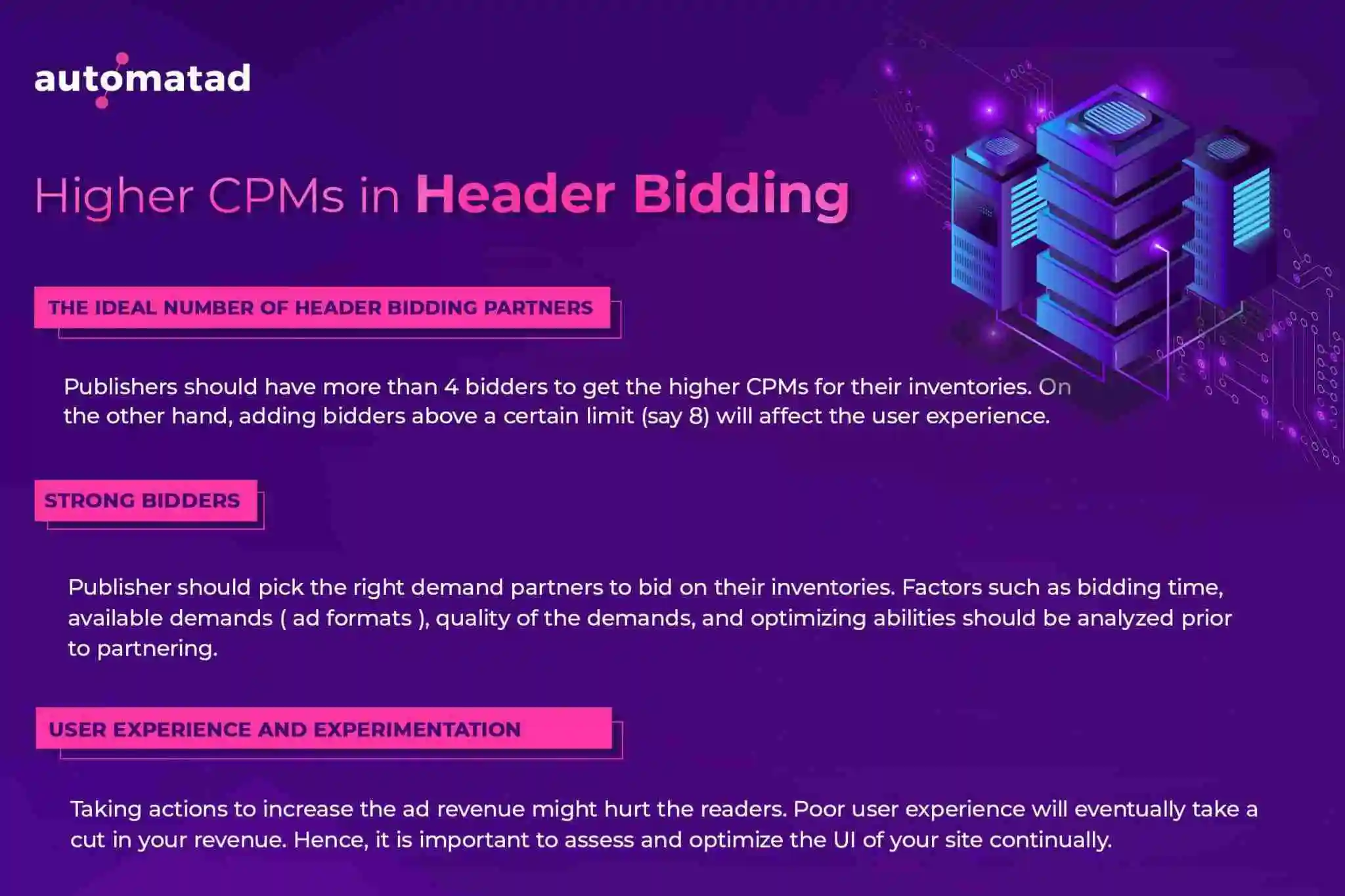Publishers’ first-look at the Header Bidding raised a question – ‘How to get Higher CPMs in Header Bidding?’. Is it enough to just implement it?
Of course, not. Publishers need to put some work and strategize the way they implement to get higher CPMs in header bidding. Let’s see what we mean.
Header Bidding and CPMs – The Dream Combo
The Digital ecosystem has gone very big and the industry has tried several times to streamline it. But it’s still in little trouble due to inefficiency and fragmentation.
Publishers sell inventory without directly communicating with the buyer in a programmatic selling. It may have an impression like automation, but it requires a lot of effort behind the curtain to connect the buyers with the sellers.
Header bidding is the technique that has taken its inception out of this. Due to the inundation of the advertisers for the same time inventory, it’s bound to create competition among the advertisers and it leads to a greater surge in the CPM for an ad impression.
Also, in this way, every buyer gets an equivalent opportunity to bid on the same inventory, right on time. No inadvertent prioritization of Google’s ad exchange.
In short, Header bidding enables a more competitive, more dynamic programmatic ad stack. It’s known that by header bidding, publishers are boosting CPMs by as much as 60%. But, why your CPMs are still struggling to climb up?
Well, we’re going to take a look at the best practices to get higher CPMs in Header Bidding. So, you don’t need to worry about the CPMs anymore.
Higher CPMs in Header Bidding
1. Choosing the Number of Header Bidding Partners
The focus of the publishers nowadays is to manifold the revenue from their ad stack. This is actually possible in the process of header bidding. However, the overall concept, in fact, is not new. Publishers have begun to realize the monetary aspect and potential, so acquisition is taking a lift.
It’s recommended to work with more than 4 bid partners to get the ideal CPM rates. However, in general, it depends on the publisher’s specific site and some trade analysts suggest working with more than this figure.
For instance, the revenue technology head at Graphiq, Mr. A J Okereke, encourage publishers to start working with a pretty good number of quality bidding partners prescribing 10 or more.
As per the industry experience, Okereke commented that all publishers have distinctive content and size but over the years in this industry he learned that monetary gains of 35 % to 50 % have been witnessed by those publishers who have worked on increasing the number of bid partners.
But the flip side of increasing the bidding partners is lousy user experience and increased site latency. It could be worse for the user experience when multiple partners are integrated which creates more requests, resource rendering, and additional latency.
Publishers will have to find the right balance between a good user experience and ad revenue. So, to make the optimum balance, it’s recommended to work with a minimum of 4 and a maximum of 8 bidding partners.
Moreover, to dodge site latency, ensuring effectiveness and an upsurge in CPM rates, it is essential to work not only with the perfect count of bidders but also ensures collaboration with the suitable bid partner.
What do we do?
We typically start with 5 bidder partners who have higher win rates and better demand for the publisher. As it takes a week to actually perceive the impact, we won’t optimize the bidder partners in a day or two.
2. Discovering the Ideal Accomplice
The purpose of almost every header bidding associate is to get the exorbitant CPM and maximal fill rate.
But how to make sure it happens?
Simple. Publishers are advised to be careful about selecting their bidding partners and have an understanding of the capacity and types of available demands.
Factors such as,
Bid rate,
Win rate,
Timeout rate,
Quality of demands (ad quality),
Ad fraud prevention capabilities,
IVT prevention (adaptive and dynamic), andF
Open wrap technology (open-source and unbiased) should be considered while choosing a bidder partner.
We advise you to manually review every bidder partner your SSP connects and then, go with the best 5 or 6 at first. If you need help assessing the bidder partners, use your own data from DFP and see who’s bidding and winning for the last 6 months.

3. Delivering the Ideal User Experience
The site visitors must get an appreciative user experience and maintaining UX needs to be a top priority for publishers, especially while finding the header bidding partner. The partners who cause latency and improper ad rendering must be dropped and you should opt to work with the best partners only.
The script shouldn’t block the content of the page and should render the ad properly. It’s crucial to satisfy your readers and then deliver ads without hampering their experience. Not the other way around.
When going on board with a header-bidding partnership, the prime concern is pace, supply-side technology, and expertise. Publishers need to be careful of these three while gauging the partners to ensure the expected support level.
4. Key is Experimenting
Publishers ultimately need a partner who exceeds the expectation – both monetarily and perceptually. It requires experimentation at the start and optimization until the end. You need a partner who doesn’t lock you in for years, just because you wanted to try and see how they perform.
Keep an eye on the site data, ad revenue, and enhance the process.
Obviously, you need help and continual learning to experiment and get the best out of your ad impressions. That’s why we run the adtech roundups and programmatic decode series. You can sign up to receive actionable insights every week.
5. Choosing the Right partners to Monetize Inventory
Though there is no shortage of monetization partners in the market, the following should be taken into account while evaluating one.
- Choose a monetization partner that brings in the right demand and assists you to create the best ad formats and better experiences that could engage users from mobile as well as the desktop web.
- Look for partners who are authentic and have a specialized team to handle mobile web monetization.
- Opt for partners who support first-party and third-party data integration and can get you access to DMP to optimize your content strategy and monetization.
- Select a partner that protects your user data by enforcing stronger data privacy policies and protection technologies. Being transparent is yet another important aspect.
Conclusion
Header Bidding was created to increase CPMs in the first place. If done right, any publisher (regardless of size and geo) should see a significant lift in CPMs. However, as we highlighted in this article, you may need to dig more and go beyond ‘standard implementation’ to get higher CPMs in header bidding.
If you need any help with the setup or looking for a header bidding partner, reach us at automatad.com. We’re glad to share our knowledge and expertise in ‘Header Bidding‘.























